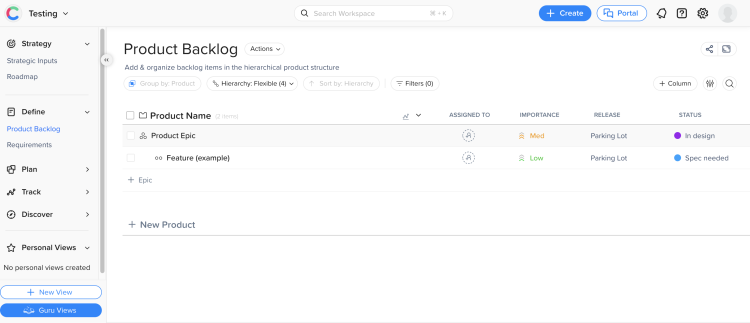
Nowadays we look at the boom of ChatGPT and are caught in the middle of a storm of brand-new generative AI tools - yet we forget that many of us also experienced a boom in product tools a few years ago. Amongst that boom landed Craft.io, a startup based in Tel Aviv.
Craft calls itself the all-in-one end-to-end product management platform, which is a big chunk to try and bite off the market. But is it really everything they claim to be?
Let’s take a deep dive into what Craft has to offer, as well as alternatives for your product organization.
TL;DR
All products mentioned in this article have clear strengths and can serve as part of a product management ecosystem. A modern product management tool must cover outcome-focused roadmaps, strong support in product discovery, easy user adoption, and seamless scalability for growing teams. According to our evaluation, airfocus is best suited to cover this full set of capabilities a modern product manager needs.
What is Craft.io, and why look for an alternative?
Craft.io was created by Elad Simon and Roni Ben Aharon in 2015. Like many other products, it came about from the personal need both founders had when managing their own products. While this isn’t an uncommon trend when building a new product, Craft seems to have gone down the path of allowing more project management than product management, perhaps alluding to how dynamic, and often misunderstood product management actually is.
Craft.io - is it project, program, or product?
Craft.io seems to be suffering from a bit of an identity crisis in its approach. This is obvious from the onboarding flow, when one is initially asked if they are a product manager, project manager, program manager, or product owner (which is actually combined with the product manager role.)
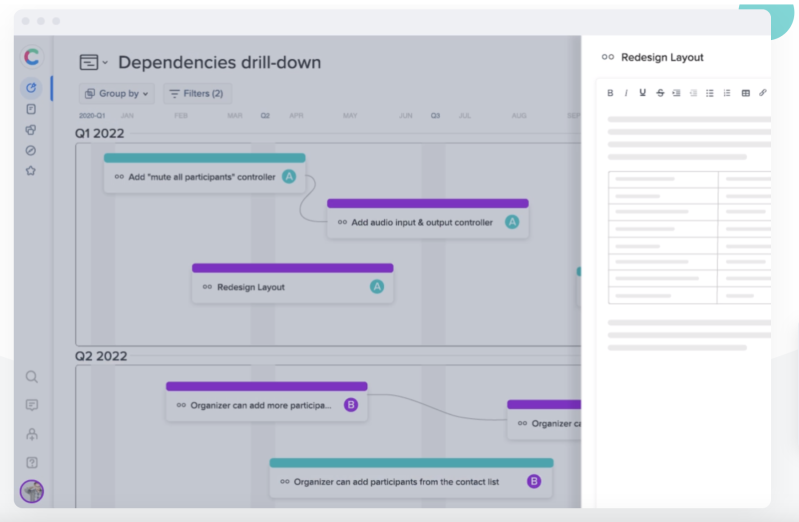
Some of the red flags that popped up while testing it thoroughly:
They see roadmaps as releases, and tie epics directly to a timeline.
Their backlog includes epics and features, as opposed to opportunities and ideas. This potentially puts any product manager in an output-facing environment.
Offers capacity planning, which doesn’t sound like an overall bad thing, but it’s primarily a project planning responsibility.
However, Craft does offer some positive product-related solutions, such as OKRs, strategic planning, and separation of the product and development workflows.
Defining Craft.io competitors
When it came to defining Craft.io competitors, we looked at answering the following questions:
How does it help with roadmapping and sharing roadmaps?
How does it help with discovery?
How does it help with prioritization?
How does it help with scaling teams?
How does it help with involving other team members?
What is their pricing like?
We chose these questions because we know better than to try and compare feature-by-feature. We chose to focus instead on the day to day of a product manager’s job. At the end of the day, PMs do a lot more than just roadmapping - we run discovery, prioritize, communicate, and work with several other stakeholders. A good product platform should support those workflows through and through.
With these questions in mind, we looked through dozen of sources and reviews online to assess our competitor list. As a result, we've chosen the five most recognizable sources to conduct an investigation:
We used these sources to find the closest Craft alternatives and compared them with one another through a variable scope.
We won’t keep you waiting any longer… here we go!
Here are your top 8 alternatives:
airfocus
Aha!
airtable
Asana
Jira
Productboard
ProdPad
Roadmunk
airfocus vs. Craft.io

In their own words: “A platform built for the new way of doing product management”
Although relatively new to the product management world, airfocus has managed to gain a lot of market share with its unique approach to product management. airfocus understands how difficult product is in practice, and designed a tool that adapts to growing and scaling teams by creating a modular platform that adjusts to a team’s ongoing needs.
From product strategy, discovery and roadmaps - all the way to insights management - they have done what other products have not managed to do: provide teams and organizations with unique workspaces catered to their own needs, without overwhelming them with unnecessary features.
Founded in: 2017
Based in: Germany
Employees: 50+
Funding: $15M
Website: www.airfocus.com
How does it help with roadmapping and sharing roadmaps?
airfocus allows organizations to create portfolios that break down into several roadmaps. All roadmaps can be shared internally and externally through easy, shareable links - making transparency and collaboration incredibly easy.
The team has taken great care of giving flexibility over how teams create and manage new views, providing pre-populated templates to get new users started quickly.
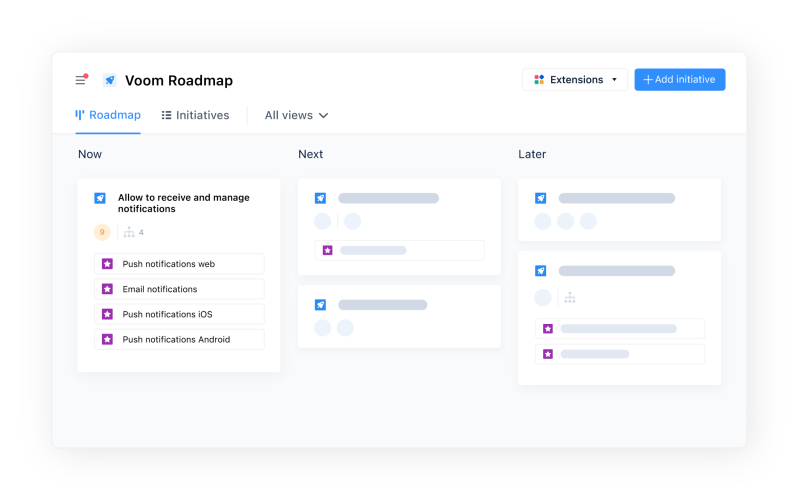
All templates and workspaces are 100% customizable, giving flexibility while providing a starting point for those that have yet to establish their own process. Whether your team needs different views, fields, or visibility options - you can truly turn this modular platform into the perfect tool for your team.
How does it help with discovery?
airfocus has a heavy focus on customer feedback, with a user portal that can be set up to engage with users directly. As with everything in the platform, the user portal is also customizable, allowing you to connect it to internal workflows for both feedback and ideas. This provides full visibility over who is saying what, and how feedback might add evidence and support for decision-making.
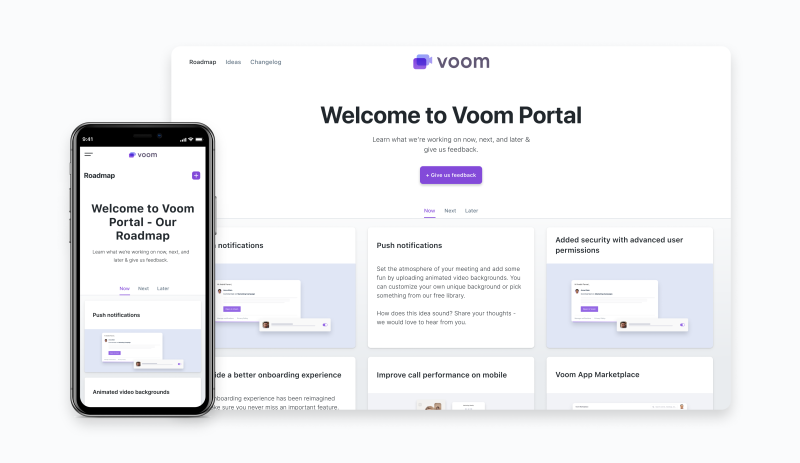
Because of its elasticity as a product, you can use any discovery framework or method - often at multiple times and across various teams. Each team can have its own space, ensuring that there isn’t any added confusion in working approaches. Only when needed do these views roll up to a source of truth, for added transparency with leadership.
How does it help with prioritization?
airfocus has the most flexible prioritization configurations in any of the available product tools. We’ve discussed customization a few times, so it shouldn’t come as a surprise when I say that each team can set up its own framework, be it RICE, WSJF, or a simple impact vs effort framework - you can use all of them. (I’m not suggesting you do that, but the option is there if you want to experiment!)
After ideas have been scored, they appear on a comparison chart, allowing you to see a more holistic view of what your potential opportunities look like.
Alongside that, the platform also offers a Priority Poker tool, which helps teams align around priority and focus. In it, a session is started for team members to score ideas individually, and then discuss what the best way forward might be.
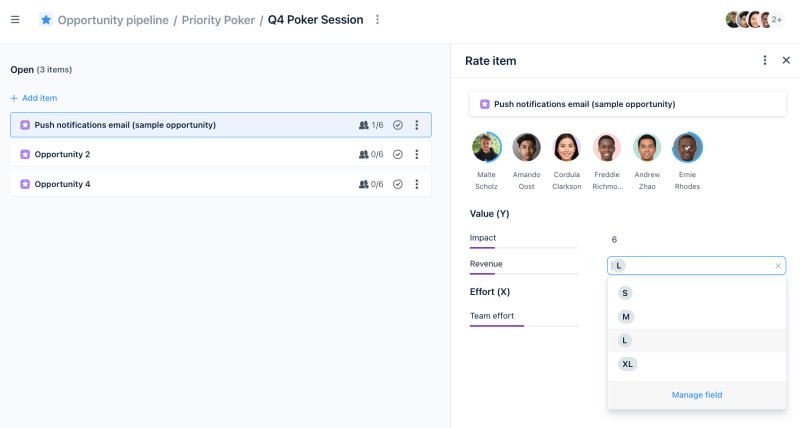
How does it help with scaling teams?
airfocus was specifically designed for growing and scaling teams. Its modular approach to product development means the tool can easily be adapted to new needs, frameworks, and workflows as changes happen. If you need something, add it. You don’t need it anymore? Remove it! Simple.
The important part is that it does not aim to force anyone to work in a certain way, but does provide useful guidance through its templates, tool tips, videos, and various educational content. The team has truly combined best practices with flexibility all in one.
How does it help with involving other team members?
Flexibility and customization might sound scary. Can you truly achieve both without having a mess of a product? Somehow airfocus has managed to achieve that. Their UI is delightful to say the least. In addition to their core product, they also offer forms, portals, and integrations for those team members or stakeholders that may show some friction in wanting to adopt a new tool.
Integrations include Intercom, Jira, Asana and many more, so you can set up a dynamic system that supports cross-team work.
What is their pricing like?
airfocus offers four pricing plans in total. Pricing is based on paid seats, but with the benefit of free viewers. Pricing starts at $59 per editor, per month; you can try for free for 14 days.
Pros and Cons
Pros:
Integrations with development tools like Jira, Trello, and AzureDevops
Ability to create and share roadmaps
A portfolio view of multiple roadmaps
Customizable fields and views
Custom prioritization frameworks + Priority Poker for team alignment
User portal and Insights app, for engagement and feedback management
AI Assist embedded feature that helps product managers draft ideas, analyze sentiment and free up more of their time.
Good UI, easy setup
Cons:
Modularity can take bit of time to get used to
Rating
G2: 4.4 out of 5
Capterra: 4.5 out of 5
Aha! vs Craft.io
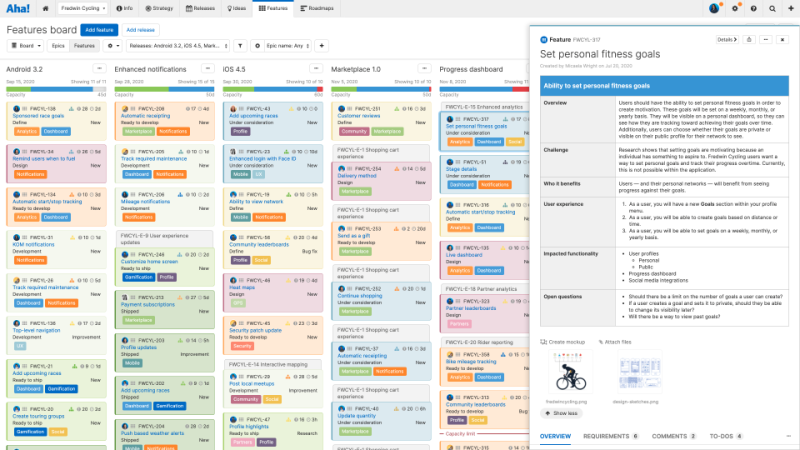
In their own words: “Anything is possible with the world's #1 product development software
Founded in 2013, Aha! was one of the first available product platforms. From the getgo it understood that product managers need more than roadmaps, and expanded its offering to include idea and feedback management. Now focusing on large project-focused enterprises, Aha! offers both product and project management solutions.
Founded in: 2013
Based in: United States
Employees on LinkedIn: 300
Funding: bootstrapped
Website: www.aha.io
How does it help with roadmapping and sharing roadmaps?
Aha! offers extensive roadmap sharing capabilities. It’s important to note though, their approach to roadmapping comes in the form of timelines and Gantt charts. If you’re a product manager wanting to apply better PM practices, such as outcome-based or theme-based roadmaps, you’ll find these options aren’t really within the Aha! realm of possibilities. That said, they do offer the ability to visualize goals and objectives, but all of these are set against a delivery timeline. This puts you in an operational project funnel, not a product one.
How does it help with discovery?
Aha! has a feedback portal where you can engage with your customers so you can gain more insights. Their portal is forum and voting based, which can be difficult with the inevitable Pareto Principle (you’ll have 20% of the loudest people sharing 80% of the feedback.)
Even if you do manage to somehow evade that, creating an internal process is impossible, as all feedback remains on the portal. This makes it difficult to establish an internal feedback management process for your team, using feedback as part of the evidence you’ll need to proceed with a decision and understand problems holistically.
How does it help with prioritization?
Aha! is quite flexible when it comes to applying different prioritization methods, but as a project-focused tool, it ties objectives to timelines and features - not problems and outcomes. It positions itself as being overly reliant on a framework rather than offering you the ability to make a decision based on evidence that sits outside any inputs needed in the algorithm. In other words - if you want the tool to make the decision for you, it might just work.
How does it help with scaling teams?
Aha! is quite flexible and provides custom fields and workflows you can set up for your team. It also offers extensive reporting tools, which will help support cross-functional work as well as reporting upwards.
How does it help with involving other team members?
Aha! comprises a suite of products: Roadmaps, Create, Ideas, Develop and Academy. They are at best clunky at times, and its usability and UI are notoriously confusing and difficult. While the general idea to be able to support cross-functional teams is there, its overly user experience makes it difficult to adopt.
What is their pricing like?
Aha! packages their product in four plans for “Roadmaps” and two for “Ideas”. “Roadmaps” starts at $59 per user per month, paid annually and goes up to $149. “Ideas” is either $39 per user per month, paid annually or $59. You’ll need both products to cover all of your product management activities.
Anything else comes at an added cost.
Pros and Cons
Pros:
Advanced backlog management
Ability to create custom fields
Extensive tracking and reporting
Crowdsourcing and engagement with customers via portal
Cons:
Roadmapping is timeline based
Project-based focus
Complicated UX/UI
Feature management is through voting, not problem solving
Rating
G2: 4.3 out of 5
Capterra: 4.7 out of 5
Airtable vs. Craft.io
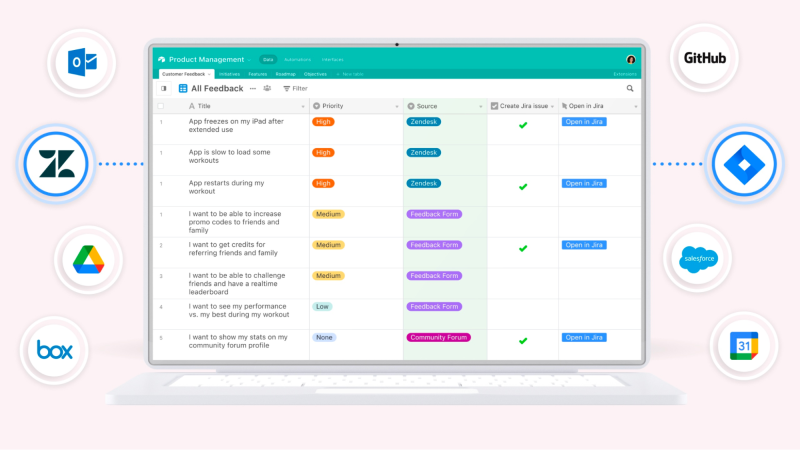
In their own words: “Connect everything. Achieve anything.”
Airtable’s superpower lies in being able to connect various systems together to work in synchronicity. With an interweaved set of databases linked together, it has the power to set up workflows for multiple teams and processes.
Founded in: 2012
Based in: United States
Employees: 1.200
Funding: $1.4B
Website: www.airtable.com
How does it help with roadmapping and sharing roadmaps?
Airtable is a super-powered spreadsheet-style database. While allowing you to set up an array of different views and apps that are linked to one another and share information, it’s important to note that this is not a dedicated product tool. As such, setting up roadmaps requires knowing how to string databases together to display the correct information. When starting from scratch this can involve quite a high implementation time.
Views can be shared via URLs, but all data is shared at once. You cannot customize what is shared, leaving you to create a separate database that needs to be maintained alongside your main roadmap. (Is maintaining two separate views really optimal?)
How does it help with discovery?
Airtable is a process tool - not a feedback tool. While you can set up external forms to be used as a way to gather feedback, it lacks on the engagement side. You can collect feedback with a custom form, but you wouldn’t be able to easily engage with customers otherwise.
How does it help with prioritization?
Its customizable and flexible approach would allow you to set up any framework you want, but optimizing the algorithms would be tricky. This would require knowledge of formulas, potentially causing issues down the line if someone else were to accidentally modify them without knowing the potential domino effect on connected databases.
How does it help with scaling teams?
Flexibility does not necessarily mean scalability. Team experts would be required to know how formulas and databases work, and control of the platform would be reserved for just a few users that could ensure it wouldn’t accidentally break.
How does it help with involving other team members?
Airtable’s UI is user-friendly, and there should be little friction in introducing it to team members.
What is their pricing like?
Airtable has four packages, ranging from a freemium version to enterprise based on user seats. Their second plan sits at $10 per member billed annually, while their third plan is at $20. The fourth plan is priced upon request.
Pros and cons
Pros:
Easy to navigate
Interconnected apps and workflows
Plenty of integrations to choose from
Cons:
Restrictive setup for roadmaps
Requires knowledge of setting up complex databases
Has a limitation on records and file uploads
Rating
G2: 4.6 out of 5*
Capterra: 4.7 out of 5**
*1460 user reviews
**1466 user reviews
Asana vs. Craft.io
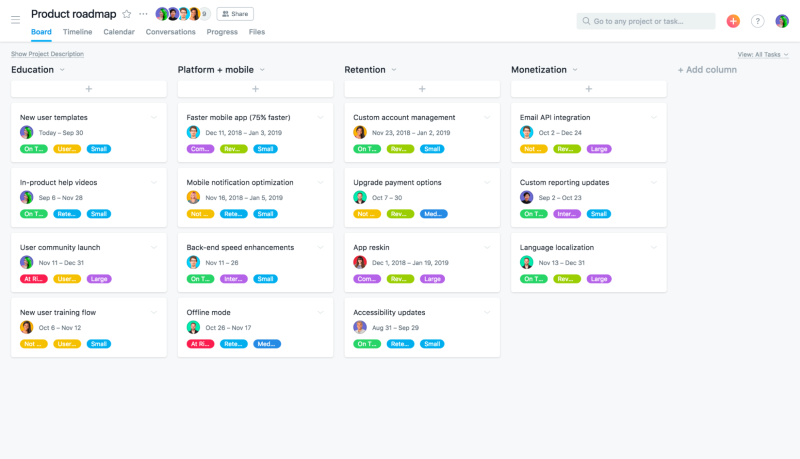
In their own words: “Bring products to market faster with Asana”
Asana is a productivity tool allowing you to manage complex work across various teams. As such, its focus is to provide teams with efficiency across the board, ensuring everyone from marketing to operations is able to manage their time better.
Founded in: 2008
Based in: United States
Employees: 2.500
Funding: $453M + IPO
Website: www.asana.com
How does it help with roadmapping and sharing roadmaps?
Asana is primarily a project tool and as such offers timeline and project-based functionality. While you can create a kanban-style board that is customizable, their focus is on the solution space, not the problem space. You can easily create shareable read-only links, but all information on the view is available on the URL. This means there is little flexibility in creating a safe view to share externally, leaving you to create a separate view every time you want to share.
How does it help with discovery?
Asana does offer you the ability to create a form to collect feedback. Internally, you can create a feedback management system to track feedback as ideas and opportunities move across the development process. The only downside is there is no user portal, but there is the ability to engage in conversations via email through one of their custom integrations.
How does it help with prioritization?
Asana manages prioritization quite well. That said, it’s task-based prioritization. They offer custom labels and fields to work around that, making prioritization simple, but effective. No custom algorithms or frameworks can be added, aside from the basics it allows.
How does it help with scaling teams?
Asana’s scalability is fantastic for anyone looking for ways to manage cross-functional projects. You can assign and follow various tasks and spaces, and create cross-team and cross-project dependencies throughout.
How does it help with involving other team members?
Asana has ensured that their UI is truly delightful, notwithstanding the use of unicorns to celebrate getting work done. Combined with its clear usability and UX, it shouldn’t be too difficult to get other team members on board.
What is their pricing like?
Asana offers three tiers paid per user, billed monthly or annually, starting for free and moving up to €10.99 and €30.49 per user per month.
Pros and Cons
Pros
Easy to use
Delightful UX and UI
Scales easily
Cons
Not designed for product managers
Heavily task-focused
Rating
G2: 4.3/5
Capterra: 4.5/5
Jira vs. Craft.io
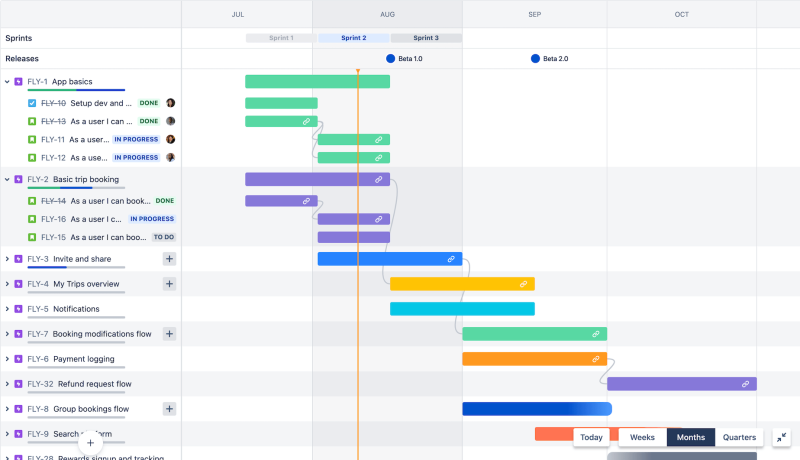
In their own words: “The #1 software development tool used by agile teams”
Jira is one of the most well-known development tools, and as part of the Atlassian suite, caters to support, operations, project, and operations teams alike. They have over 3000 integrations to choose from, ensuring cross-tool collaboration for all.
Founded in: 2002
Based in: Australia
Employees: 15.300
Funding: $210M (Secondary market) + $462M (IPO)*
Website: www.jira.com
*Data for Atlassian, Jira’s parent company
How does it help with roadmapping and sharing roadmaps?
Jira has recently gone hard on trying to be more attractive for product managers, expanding their capabilities to include roadmapping. While both timeline and board views can be created, it is difficult to share them outside of the Atlassian ecosystem. This would make transparency difficult, especially when wanting to share your roadmap with your board members or customers.
How does it help with discovery?
Jira has recently released Jira Product Discovery, which is essentially the product management side of their project software side (Jira Software.) Jira doesn’t actually collect feedback on its own but rather integrates with all the other tools you’re already using to gather, organize, and track feedback against ideas.
How does it help with prioritization?
Much like everything in Jira, setting up a prioritization framework is doable, but will require an IT manager to allow you to set up and manage custom fields. It’s important to note that algorithms are not used, but rather scoring inputs that allow you to prioritize a task (not holistically compare items to one another.)
How does it help with scaling teams?
Jira is scalable- it’s built for that. However, its notorious lack of usability and UX tends to be the number one reason other team members do not want to join. In addition, scaling comes with complicated permissions, which are generally managed by an IT department, and everything would have to go through them before you’re able to invite someone else or set up anything to expand your workspace.
How does it help with involving other team members?
Can you involve other team members? Yes. Will they want to log in? That’s certainly debatable! While Atlassian has taken great steps in expanding its offering to include support, product, and operations to its system, it has failed in actually making the platform user-friendly.
What is their pricing like?
Jira is available at four different prices: free, $7,50, and $14,50 per user, per month (no matter if paid annually or monthly). Lastly, an enterprise tier, only available with annual billing from 801 users at $10,70 per user per month.
Pros and cons
Pros:
Over 3000 apps and integrations are available
Customization of boards, reports, timelines, and views
Good scalability with larger teams
Cons:
It is not a product management tool - but they’re trying!
Time-consuming management process
Confusing layout, configuration, and UI
Rating
G2: 4.2 out of 5
Capterra: 4.4 out of 5
Productboard vs. Craft.io
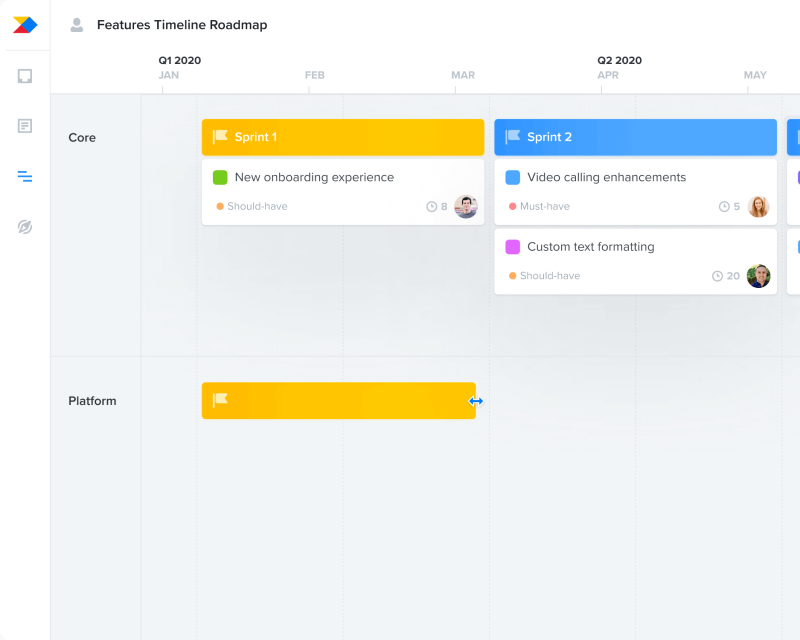
In their words: “Get the right products to market faster”
Productboard has exploded into the product management scene over the last few years. Like many of its kind, Productboard allows product managers to build roadmaps, manage their backlog, and collect feedback, supporting PMs in their day to day.
Founded in: 2014
Based in: United States
Employees: 500
Funding: $262M
Website: www.productboard.com
How does it help with roadmapping and sharing roadmaps?
While Productboard does offer you to create roadmaps, it has some very clear red flags waving at you from the very beginning.
Their “Now, Next, Later” roadmap is actually based on releases, not outcomes.
The only other option they offer is a timeline roadmap
They offer an option called a “Kanban roadmap” - which is not a term that actually exists (and it’s based on releases.)
They only offer the ability to create “features”, not ideas or opportunities.
Once you manage to create a board-like roadmap, they map features directly to the roadmap, completely bypassing the initiative level. While they do seem to be investigating initiatives, they also want to tie them directly to timelines, once again, misunderstanding the purpose of what a roadmap is.
How does it help with discovery?
Productboard seems to be giving mixed signals in this department.
Boards can be created, but only on the roadmap level as far as I was able to deduce (maybe there’s something to be said about usability there.) Likewise, there is a portal and feedback management system, but all opportunities these might be linked to are actually features, potentially leading product managers down the path of ‘build it all’ rather than ‘understand what you’re doing first.’ Quite a move for a product that claims to allow you to build the “right” product. Not quite sure how any of this counts as discovery work - but they do get bonus points for having an engaging and beautiful user portal.
How does it help with prioritization?
Productboard does offer you to set up custom fields so you can prioritize to your heart’s desire. These algorithms cannot really be adjusted, and the scores can’t easily be used to compare items to one another - but if you’re looking for a simple and easy way to prioritize (like impact vs effort), then it’s a great way to get started.
How does it help with scaling teams?
There are a few potential downsides to Productboard when it comes to scaling teams:
Everyone works in the same workspaces, meaning you’ll have to have the same workflows and processes as everyone else, without flexibility.
It can get quite expensive as you move up their tiers.
The UI can be quite complicated, with a lot of clicking around until you guess where things are at.
However, if you’re a team with super tight workflows and have a big budget, it might just work.
How does it help with involving other team members?
The internal platform is quite complicated to use, but its user portal is quite delightful. If you’re ok having your team submit feedback via the portal, it’ll be easy to get others involved.
What is their pricing like?
Productboard has four different price plans, billed per user per month. Starting at $20, and continuing at $80, with the upper two plans available on request.
Pros and Cons
Pros:
Great user portal experience
Integrations with Jira, Zendesk, Intercom
Good feedback management system
Cons:
They don’t seem to understand what roadmapping or product discovery is
Poor Jira integration
Calls everything a “feature”
Can be quite expensive
Rating
G2: 4.5 out of 5
Capterra: 4.5 out of 5
ProdPad vs. Craft.io
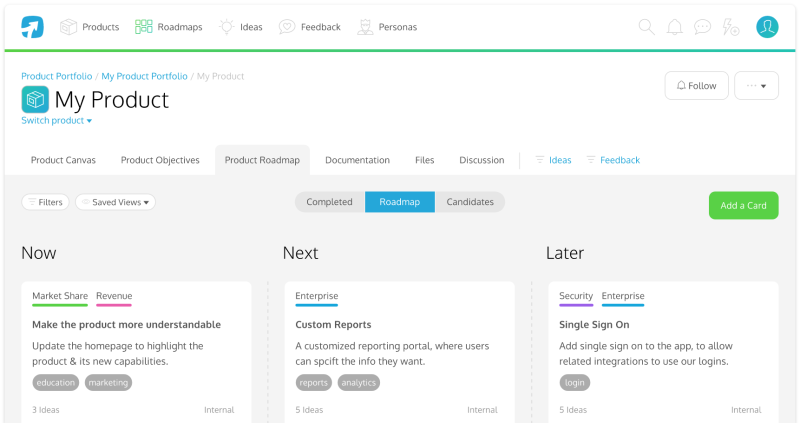
In their own words: “Roadmap, idea, and feedback management that ties actions to outcomes”.
ProdPad is one of the few tools in the product world that actually focuses on outcomes. The tool makes sure you set out with the best practices right from the start, and is definitely a great resource for any team or product manager looking to get started with outcome-based work.
Founded in: 2012
Based in: UK
Employees on LinkedIn: 20
Funding: Bootstrapped
Website: www.prodpad.com
How does it help with roadmapping and sharing roadmaps?
ProdPad created the original Now, Next, Later roadmap, which puts them in a unique position to really talk about how to do it right. Their roadmaps are simple yet informative, with customization available for sharing purposes. All roadmaps can be shared via a PDF, URL or through an embed code.
You can also create a portfolio view, wrapping up several roadmaps into one for added transparency.
How does it help with discovery?
ProdPad has a portal and widget that you can use to gather feedback from customers, as well as the ability to set up custom workflows. Customization on the widget and portal are a bit limited, and are created and shared independently from the roadmap, which means you’d have to share multiple different codes and links instead of having one space to do so. Workflows are shared across the entire platform and only exist on the backlog level, leaving little room for flexibility when working across multiple teams.
How does it help with prioritization?
ProdPad offers a very basic impact vs effort scale, which you can use as a fibonacci sequence, 1-10 scale, or as t-shirt sizes. No customization is available beyond choosing the scale. If you’re happy with this approach, you won’t have any issues comparing items with one another on their priority chart, which allows you to visualize key strategic items and potential losses.
How does it help with scaling teams?
ProdPad forces everyone to work out of a single workspace, with no customization over fields, workflows or processes - siloing everyone to work in the exact same way. Workspaces are available with an Enterprise account, but these are not connected to each other (they’re separate accounts, which you can switch between easily, but no data is connected.)
How does it help with involving other team members?
ProdPad hasn’t done a lot in the way of involving anyone outside the product team. While it is easy to use, it has no integrations with business-facing apps like Intercom or Zendesk, leaving you to rely on tools like Zapier to create integrations. While they do offer a ‘reviewer’ role (available for free), all features are available to all roles and permissions at the same time, making it difficult to guide your team towards the right area.
What is their pricing like?
ProdPad’s pricing is based on modules and power-ups. Their base modules are all $20 per editor/per month for access to roadmaps, ideas and feedback. Their power ups are all $10 per editor per month, and include things like portfolios, OKRs, publishing and portal access.
Pros and cons
Pros
They’re the roadmapping experts
Ability to create a portfolio view
Has access to feedback and portals
Cons
No customization of fields or views
No customization of workflows or processes
No customization of prioritization frameworks
Little in the way of scalability for cross-team collaboration
Rating
G2: 4.2 / 5
Capterra: 3.8 / 5
Roadmunk vs. Craft.io
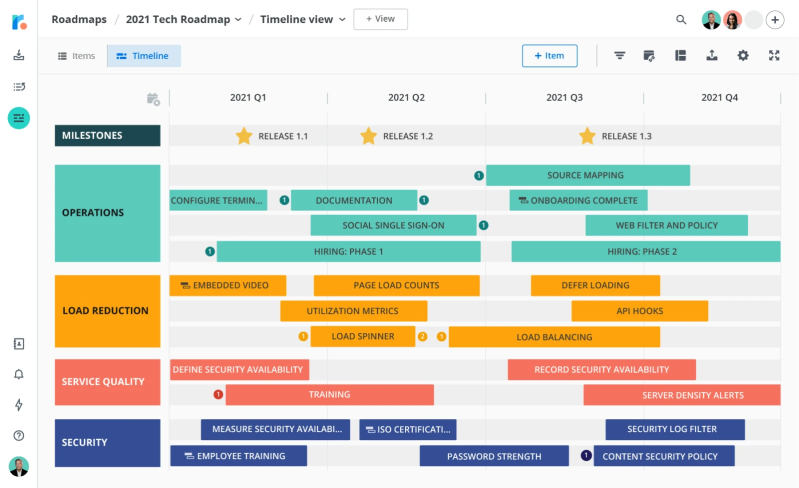
In their own words: “The end-to-end roadmapping tool. Capture customer feedback. Prioritize what to build next. And use boardroom-ready roadmaps to communicate your strategy.”
The Canadian startup Roadmunk began as a roadmap-only solution, over time extending their offering to include backlog and feedback management. Now offering a whole suite of tools, it has shown its ability to adapt within the market.
Founded in: 2012
Based in: Canada
Employees: 60
Funding: $1,7M (bought by Tempo at an undisclosed price)
Website: www.roadmunk.com
How does it help with roadmapping and sharing roadmaps?
Roadmunk provides an extensive library of templates, including timelines and outcome-based roadmaps across various themes, industries and project types.
All roadmaps are easy to share, and come in formats such as CSV, PNG, HTML and publishing to a URL. That said, do watch out for terms like “scrum roadmap” and “kanban roadmap” - neither of which actually exist.
How does it help with discovery?
Roadmunk seems a bit confused when it comes to what discovery means. Their website states they can assist with “committing to ideas” - which depending on how you read that, may indicate they’re either leaning towards a feature factory, or helping you with decision-making (not entirely sure, but let’s give them the benefit of the doubt on this one.)
They do offer a portal and feedback inbox to aid with discovery, but both lack extensive workflow management. There are only two statuses available on the inbox: “New” and “Processed” - with no workflows in between. While it’s a good start to what could become a more extensive and flexible system, if they don’t adapt that area quickly, it’ll cause more work for users in the future.
How does it help with prioritization?
Roadmunk does offer prioritization frameworks, but they are currently limited to RICE and impact vs effort. It also offers other data points such as time estimations and revenue, which I’m not sure necessarily lands within product management, but it’s a way of being inclusive of more data. If you are happy with a really simple framework, this might just work for you. However, if you wish to add more into consideration (or adapt the options further), you may find it a bit too restrictive.
How does it help with scaling teams?
Roadmunk is great for smaller teams, but its lack of customization as well as limited workflows and processes would make it hard to scale. Like many other product tools, they try to force everyone into a box of what they know works (for them), but fail to understand that teams everywhere are different.
They also only offer two integrations out of the box: Jira and AzureDevops. For everything else, there is an API available, but it would require input and capacity from your development team to help and maintain the integration.
How does it help with involving other team members?
You can mention and collaborate with other team members, but their UI is a bit bare, and at times difficult to figure out.
What is their pricing like?
Roadmunk offers four price tiers starting at $19 per user per month, billed annually. The second and third tiers are $49 and $99 respectively. Enterprise pricing is available on request only.
Pros and cons
Pros:
Over 50+ templates available
Has a feedback portal
Has integrations with Jira and Azure Devops
Cons:
Costly for small teams
No flexibility for feedback management
No scaling options
Rating
G2: 4.1 out of 5
Capterra: 4.4 out of 5
Conclusion
Craft has made an attempt to grab the market with their take on product management, but has mixed up a few disciplines with it in the process. It seems better suited for product managers who also share project management responsibility, and at best program managers who need a way to organize their work. While we will continue to keep an eye on how it evolves, there may just be better tools out there to help empowered product teams.
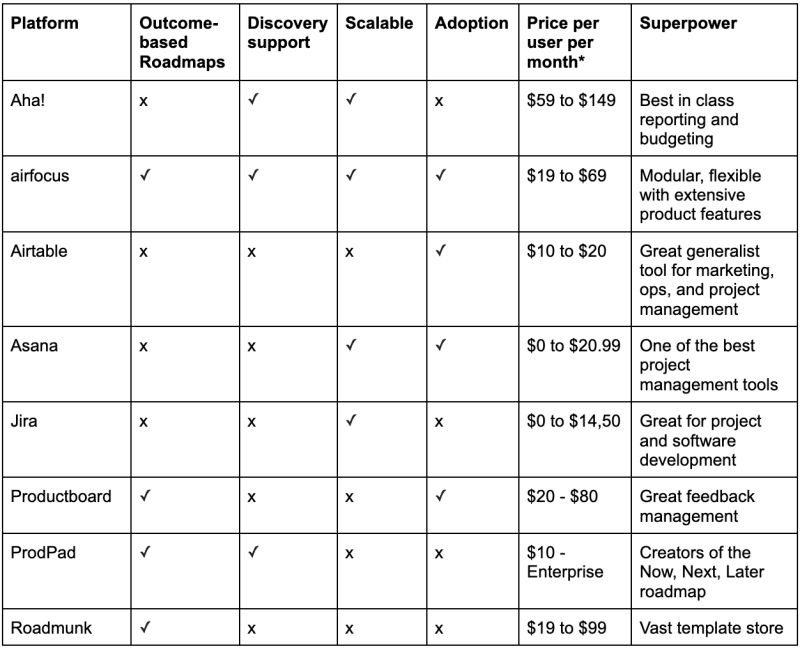
* public prices only, billed annually. All companies offer custom enterprise prices on demand.
If you want to learn more about applied modern product management, feel free to check out our academy guide on just that.

Nouran El-Behairy
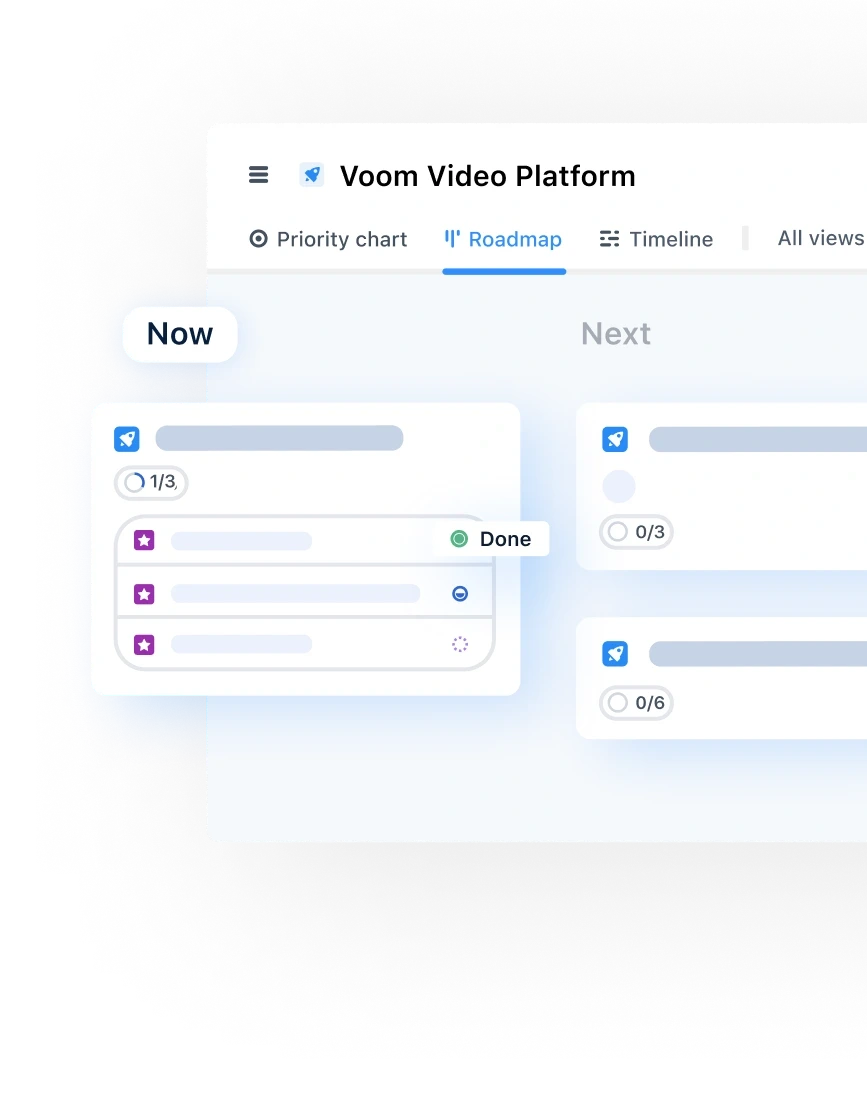
Read also

Experience the new way of doing product management

Experience the new way of doing product management






